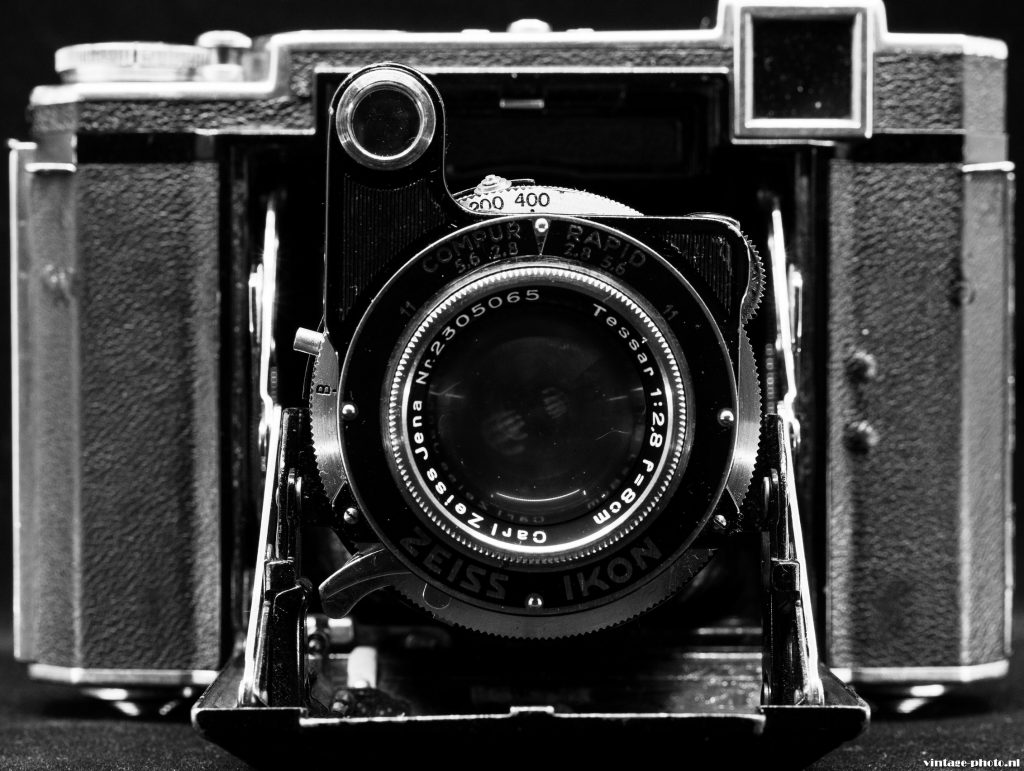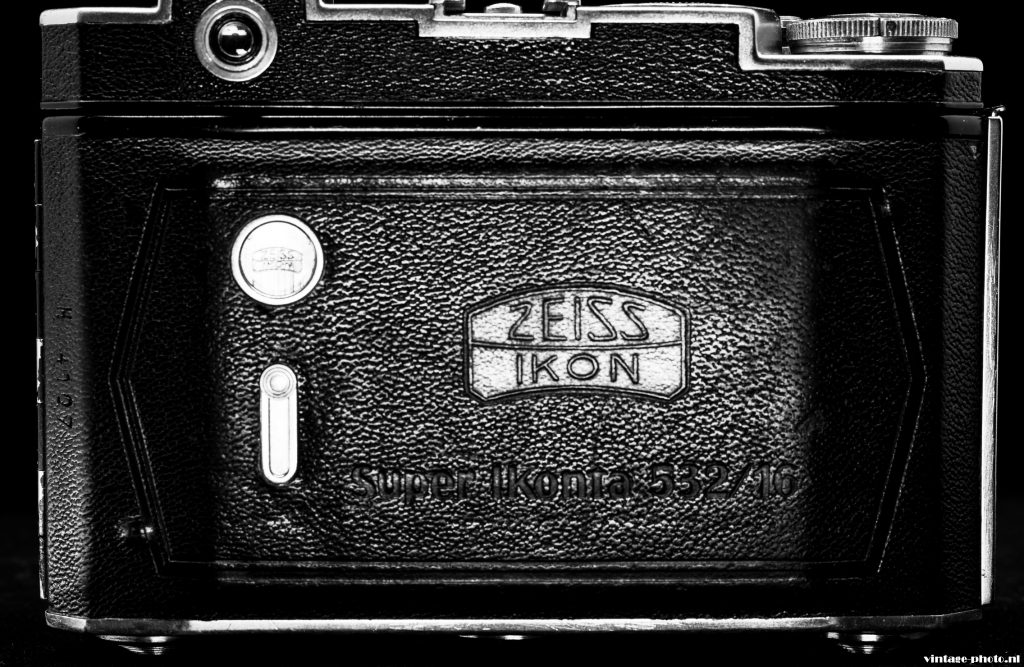Zeiss Ikon has a special place in (German) camera history. The company was formed in 1926 by the ‘Great’ merger of the Contessa-Nettel, Goerz, Ernemann and ICA companies. In general, the products were superior to those of the competition, both in design and in quality. Market leader with the Super Ikontas as medium format rangefinder cameras. The most famous and popular is undoubtedly the 6×6 series “532/16” produced between 1937 and 1955. I am the proud owner of an excellent copy dating from 1938. An impression of its use 83 years after the first picture was taken with it.
It all started with large and medium format. Photography. First glass plates as ‘negative’, later single film sheets and the first films appeared at the end of the 19th century. Well-known formats for large and medium format were 13x18cm, 9x12cm, 6x9cm and the well-known ‘4x5inch’. Mainly intended for professional photographers. It was not until the 20th century that the consumer camera made its appearance. At first, the folding bellows camera with sheets or film adapters. In the 1920s, the Leica or Barnack format was introduced, the small roll film that allowed consumers to take more than the usual 6 or 12 shots (depending on the photo format of 6×9, 6×6). Now 35mm film could take pictures on 36x24mm, very small for that time but up to 36 pictures on a single roll. Kodak introduced the most known 135 film in 1934. This was probably the biggest boost for the consumer camera market, but also marked the demise of the 120 film and the medium format camera. The corresponding 35mm cameras appeared in large numbers from many different manufacturers and this format is known today as ‘full frame’. Between roughly 1900 and 1950 the medium format camera was the most coveted quality camera. No wonder, the large negatives give a lot of room for contrast and sharpness, much more than 35mm can. Compared to pixel density, a medium-format 120 film image can record an equivalent resolution of approximately 83 million pixels in the case of a 6 x 6 cm frame!
I still marvel at the very high quality of the medium film format pictures. The photos have unprecedented sharpness and detail. But it is not just the film format. Just like now, the quality of the camera and especially the lens are of great importance. While cameras have only got better over the years, the same cannot be said for glass. Even at the beginning of the 20th century, phenomenal lenses were being built. Lenses that many people still like to adapt to their digital cameras. This also explains the popularity of vintage lenses. Perhaps not as well coated as today, the construction and quality of the glass used are just as good as today, some argue even better.
It is a long introduction, but also an important context for reviewing one of the most popular medium format cameras: the Zeiss Super Ikonta 532/16, the successor to the 530. The main difference with that model is the larger and combined rangefinder viewfinder. There were no SLRs yet, cheap cameras only had a viewfinder and zone focusing, distances had to be ‘estimated’ to get sharp pictures. Rangefinders, on the other hand, were expensive but were able to focus in an ingenious way using in the rangefinder window or patch two images of the same subject, one of which moves when a calibrated wheel is turned; when the two images coincide and fuse into one, the distance can be read off the wheel or in case of a coupled rangefinder, the lens is in perfect focus position. The designation for the coupled rangefinders at Zeiss Ikon is Super Ikonta. The uncoupled rangefinder also exists, the Ikonta 520/16 series.
The first thing to notice is that the camera only takes 11 shots instead of 12 to avoid so-called frame overlapping problems. But the heart of the camera is the unrivalled 80mm f2.8 Tessar lens, one of the best of its time. But the heart of the camera is the unrivalled 8cm f2.8 Tessar lens, one of the best of its time. For the late 1930s, it was extraordinary that an automatic film stop and film counting mechanism could be added. But the high-end model also had an PC flash socket on the shutter for X-synchronisation, a selftimer, a double exposure prevention. The coupled rangefinder had a rotating wedge and viewfinder and rangefinder were combined. All that was measured with a compact, but heavy 990 grams housing of leather and sturdy metal. The shutter was a new 1935 Compur Rapid with a fastest shutter speed of 1/400s. This became by far the most reliable and widely used shutter on high-end devices. The camera still has an old-fashioned red viewing window on the back to read the negative numbers. The shutter button is connected with a lever to the Compur at the front of the bellows. That is also where the shutter speed and aperture rings are located (up to F22).
What will it be like in 2021 to shoot with an 83-year-old camera? The 120 film rolls are readily available, in colour and b/w. Inserting them is easy. Insert the film from left to right. Turn the wind knob left until the number 1 can be read in the viewing window at the back of the camera. Then push the film-counter button and turn it to the mark 1 below the arrow. Now close the viewing window and follow the numbering on the film counter. This is calibrated to the correct film frame/spacing. First set the shutter speed and the aperture, then later cock the shutter, not before! The camera is equipped with a prevention feature to avoid duplicate exposures. You have the camera under control very quickly, usually you only forget to cock the shutter…
My preference for uncoated lenses like the Tessar is to use b/w films. The colour films tend towards too much magenta and are very inconsistent in colour reproduction. Also bear in mind that these cameras are made for b/w. The lens is razor-sharp in the centre and tends towards soft edges, characteristic of much reading from that time. At the same time, the lens gives a picturesque look to all your photos. A gallant softness opposite to the 3D pop effect of the digital lenses. As if you were taking vintage photographs of people and objects in the 21st century. No filter in your Adobe collection can imitate this effect. There is no need to worry about the overall quality, which is exceptional. You will also stand out if you take pictures with such an old bellows camera.
And therein lies the greatest fun factor: it is incredible fun to operate such a camera, the time you have to take to prepare everything before you can take a picture. Composition and focus suddenly become even more important. You only see the result much later, in your darkroom or after the negatives come back from the lab. Photography as it was done in the last century, with patience and passion. I highly recommend the Super Ikonta. It is one of the best medium format cameras with a very good reputation on the second hand market. Most of them are still in good working condition and repairable by many professionals.





















I have one of the same vintage and in the same wonderful condition, and use it regularly. I completely agree with your assessment and comments, especially about the particular quality of the lens. It’s an absolute pleasure to use once you get familiar with the operation.
My father, born 1924, owned a 530/16 which I have today. It works perfectly. An absolutely beautiful machine, gorgeous images. I treasure it.
I also have a Super Ikonta 532/16. I’m an old, retired, 77yr old newspaper photographer and simply love the quality of this camera and the remarkable images it produces. During the past couple of years, I’ve returned to my first passion, black and white film photography with my Leica, Rolleiflex, Linhoff, and now Super Ikonta 532/16
I guess it’s a German thing….ha!
I had been looking for one of these on eBay and just got lucky. It should arrive in the middle of next week. Good to know about the eleven shot deal, I might have been baffled. I’ve been using Rollei Retro 400 S on my 6×9 and getting dangerously sharp results. I’ll try developing it in Adenol(Rodinal to the pre-dugital generation) and even experiment with stand development. Expect squeaks of excitement or groans of despair. Your review was excellent, I learnt a lot, Stefan